Background of problem
- Decubitus ulcers (aka pressure ulcers/ bed sores) develop on dependent body surfaces in patients who undergo prolonged immobility.
- Pathogenesis:
- Compromised circulation due to pressure;
- Friction leading to skin and subcutaneous tissue destruction;
- Risk factors for developing bed sores:
- Immobility;
- Diabetes mellitus;
- Malnutrition;
- Poor hospital care;
- Peripheral vascular disease;
- Advanced age.
Decubitus ulcers, also known as pressure ulcers or bed sores, are wounds that develop on dependent surfaces of the body in patients who undergo prolonged periods of immobility. These wounds develop on skin and subcutaneous tissue under longstanding pressure from deep bony structures as a result of maintaining one body position for long periods of time (Carville, 2018). Patients at risk of developing decubitus ulcers include paraplegic, comatose and orthopedic patients.
Common sites of pressure ulcers include the sacrococcygeal region, heels, hips, upper back and elbows(Black, 2015).
Pressure sores occur mainly due to compromised circulation in dependent tissues caused by pressure on tissues over bony surfaces, leading to ischemia. Shear forces due to friction between the body and other surfaces also lead to destruction of skin and other subcutaneous tissues (Elahad, McCarthy, Goverman, & Kaafarani,2018). Combination of these factors leads to development of an open wound with poor healing.
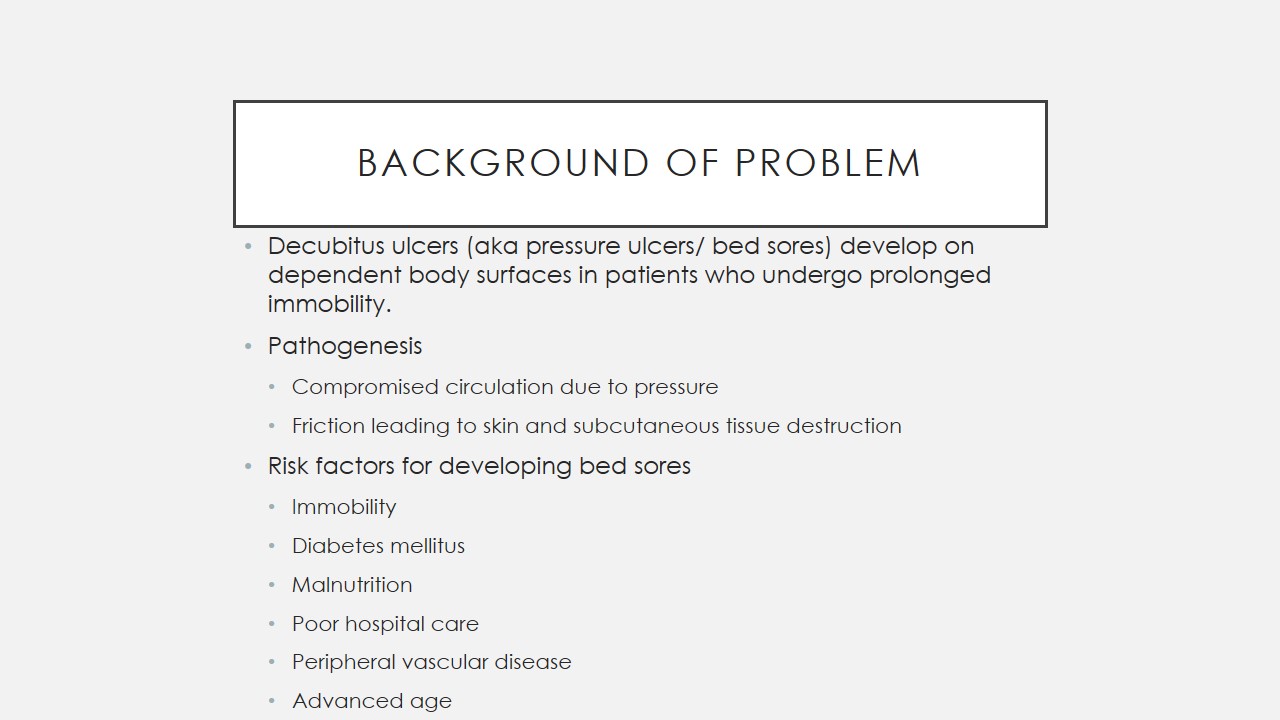
Rationale for Root Cause Analysis
- Pressure sores common in hospital/hospice facilities:10.5%-26% in palliative care settings;
- Majority of patients are 70 years or older, who are at higher risk of:
- Comorbidities e.g DM, hypertension, renal failure, cancer;
- Overwhelming infections due to reduced immunity;
- Decubitus ulcers:
- Are iatrogenic: most occur during prolonged hospitalization/wheelchair use;
- Are preventable and treatable in early stages, but hard to manage in severe injury/infection;
- Predispose to bone and soft tissue infections, causing sepsis, necrosis and gangrene;
- Health care facilities should assess the different risk factors for bed sores within their setting and implement viable solutions.
Pressure sores are relatively common in hospital and hospice facilities, with a prevalence of 10.5% to 26.0% in palliative care settings (Carville, 2018).
Majority of patients with bed sores are above 70 years of age.
These patients are at increased risk of comorbidities such as diabetes mellitus, hypertension, renal failure and cancer, and overwhelming infections following ulceration due to compromised immunity. They are thus more likely to develop severe sequelae such as tissue necrosis, multiple organ failure, and death.
Decubitus ulcers are considered an iatrogenic problem, as majority occur during prolonged hospitalization and wheelchair use. Pressure ulcers are preventable and can be treated if detected early, but are very hard to manage once significant injury has occurred (Hommel et al., 2017).
Decubitus ulcers predispose patients to bone and soft tissue infections, leading to sepsis, necrosis and gangrene, and complicating the patients’ already poor state of health.
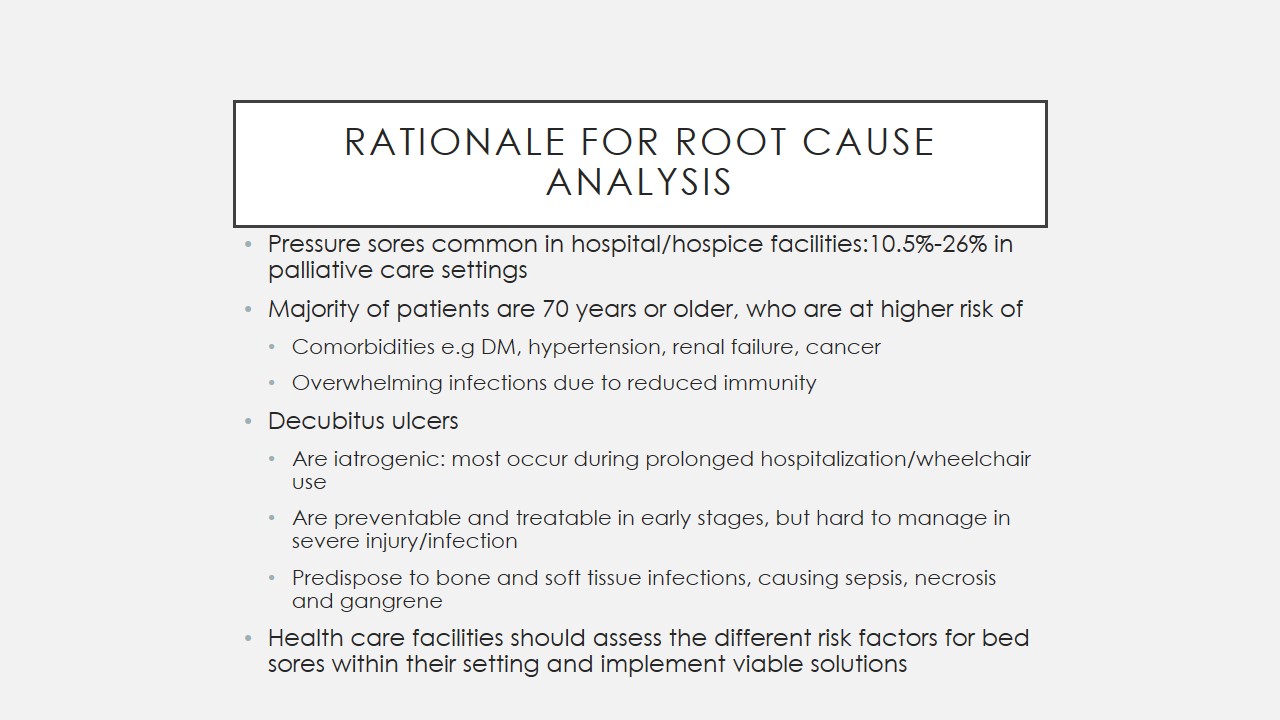
Targets/Goals of a3 analysis
- Reduction of incidence of bed sores.
- Early identification and prompt treatment of bed sores.
- Interdisciplinary approach to care for decubitus ulcers.
The goals of A3 root cause analysis in the context of decubitus ulcers include: reduction of number of patients who develop severe bed sores during hospitalization and wheelchair use; early identification of decubitus ulcers and prompt management to prevent development of severe complications; and adoption of interdisciplinary approaches to prevention of and care for decubitus ulcers.
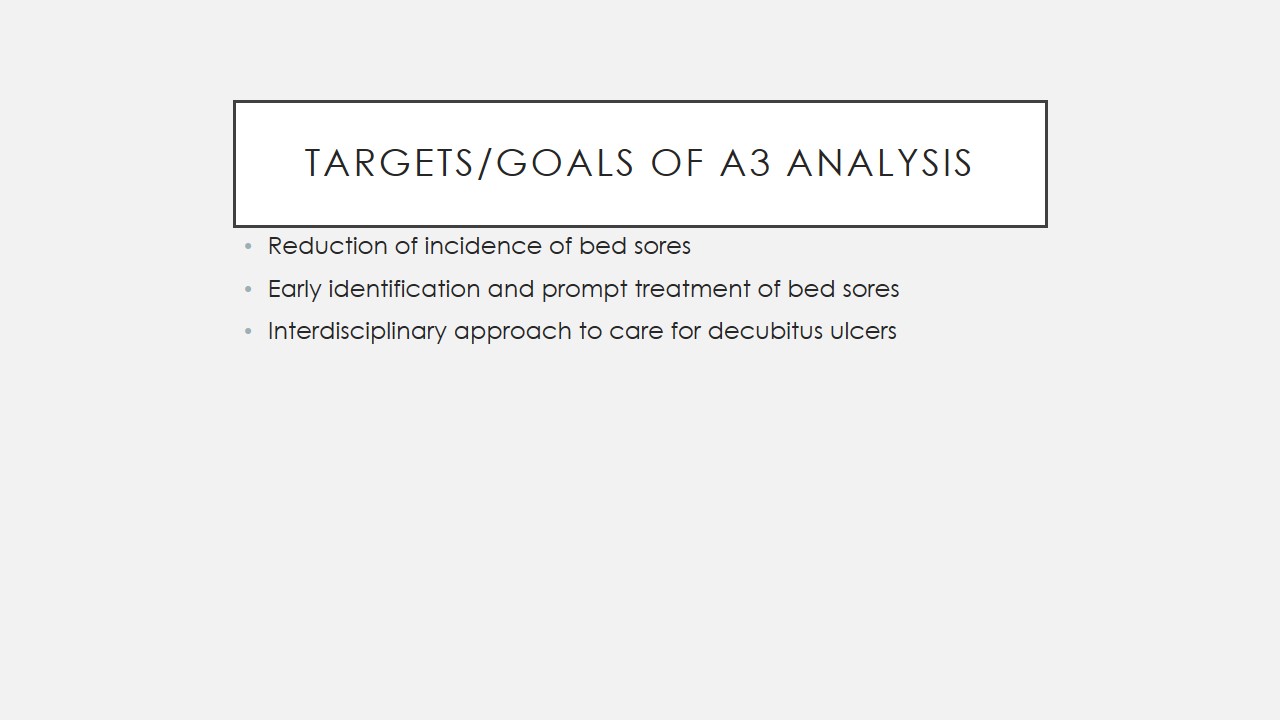
Fishbone RCA model for decubitus ulcers
The fishbone model above illustrates the different categories of factors that may contribute to the incidence of bed sores in hospital environments.
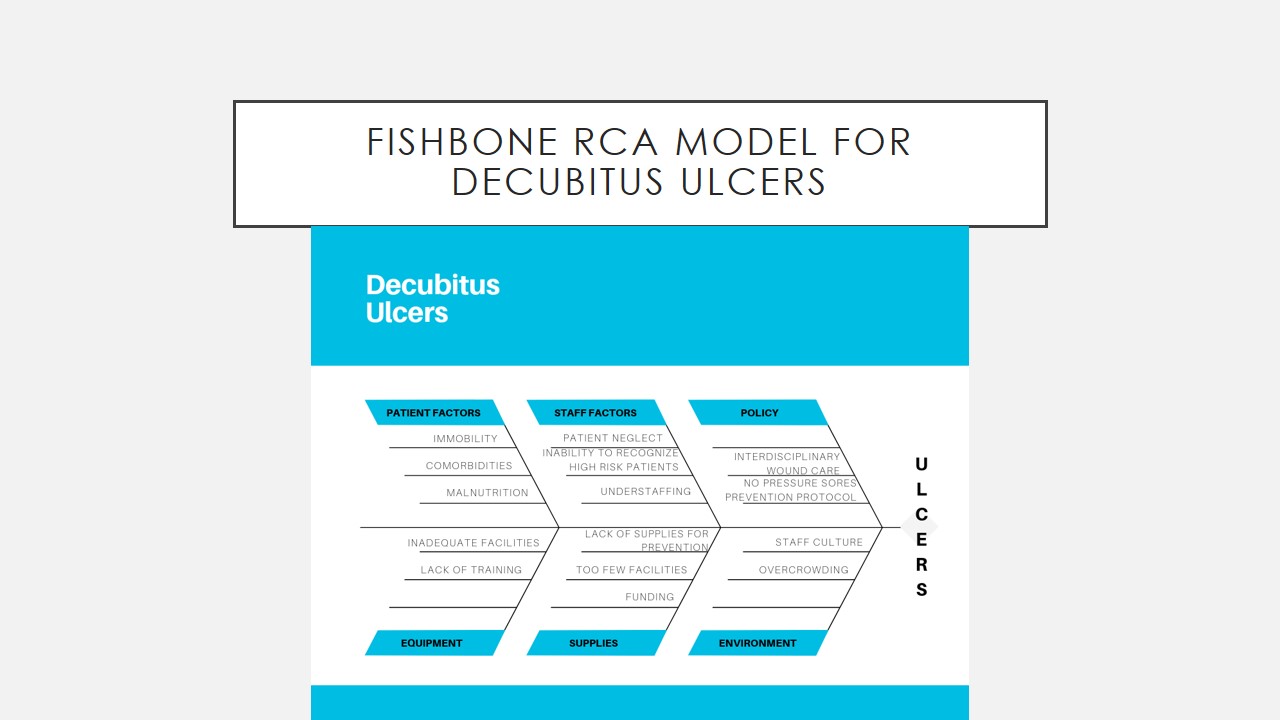
A3 Action plan
- Preventive strategies:
- Sheepskin overlays and braces;
- Turning patients regularly to redistribute pressure;
- Adequate patient nutrition;
- Skin moisturization;
- Use of risk assessment tools:
- Increasing staff capacity:
- Hiring more staff;
- Training staff to recognize pressure sores early and intervene.
- Interdisciplinary management of bed sores.
The A3 Action Plan for prevention and care of decubitus ulcers in hospital is multifocal. Preventive strategies are employed when caring for patients confined to beds or wheelchairs for long periods to prevent development of sores. Such strategies include: sheepskin overlays, beddings and braces for dependent areas; scheduled patient turning every few hours to redistribute pressure; ensuring adequate nutrition and hydration for the patient; and regular washing and moisturization of skin (McInnes et al., 2015). Use of risk assessment tools such as the Braden scale has also been implemented (Qaseem, Mir, Starkey, & Denberg, 2015). Staff capacity is also being increased through hiring as well as training staff to recognize patients at risk of bed sores and implement necessary strategies to protect them. Interdisciplinary management of sores, involving all cadres of health staff is also being encouraged.
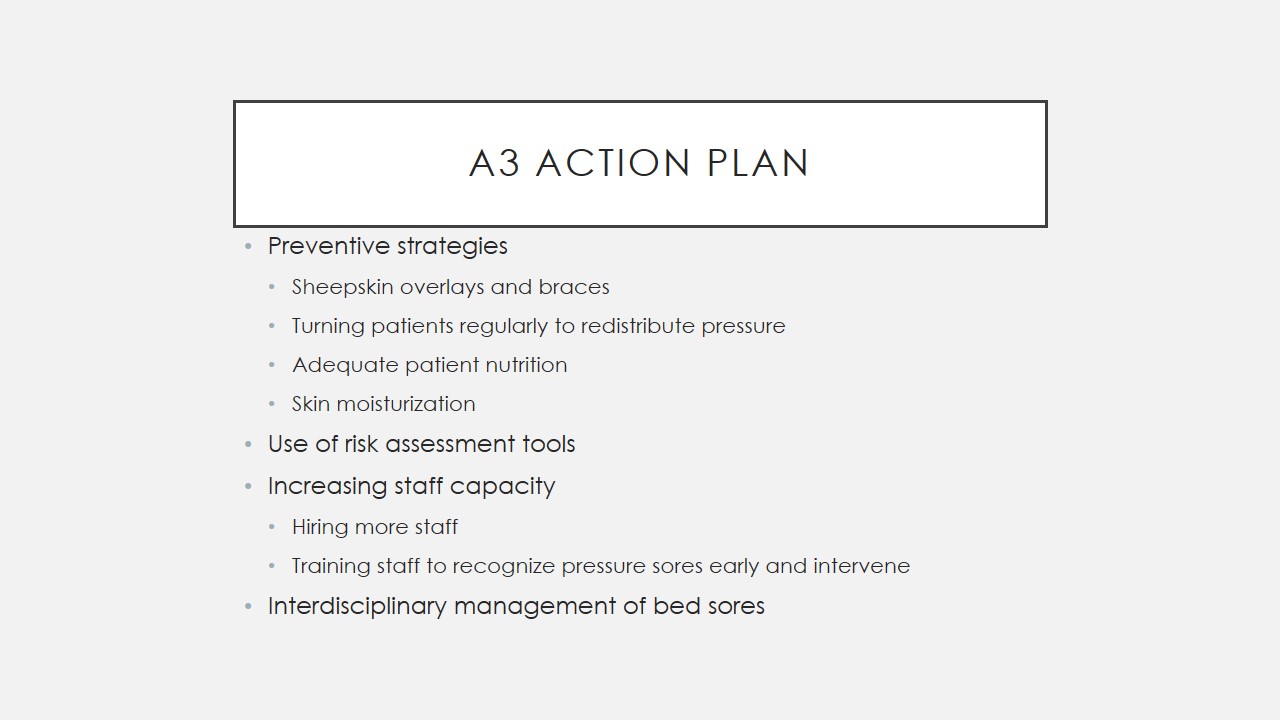
Monitoring and evaluation of a3 action plan
- Monitoring methods:
- Prompt case reporting;
- Weekly summary reports;
- Regular hospital audits;
- Continuing medical education;
- Evaluation: A3 plan was successful:
- Reduced incidence of bed sores;
- Reduced progression to severe stages;
- Improved recovery from early sores;
- Interdisciplinary approach to treatment.
The A3 Action Plan is being monitored using the methods listed to assess the efficacy of the changes in alleviating the problem of decubitus ulcers, with success being marked by reduced incidence of sores, reduced progression of sores that do occur to severe stages and complications, improved recovery from sores that are detected early, and successful implementation of interdisciplinary treatment of patients.
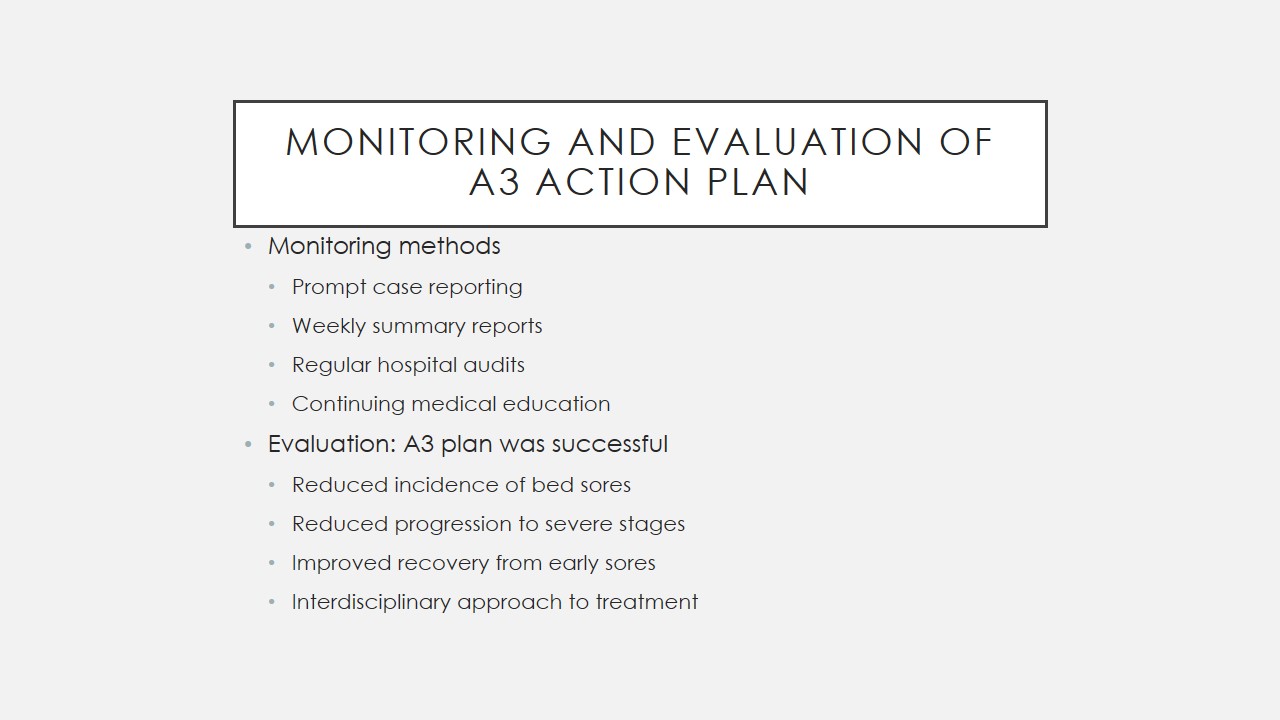
Conclusion
- Decubitus ulcers are often a byproduct of inadequate care for chronically immobile patients.
- Root cause analysis helps to group the different causes of pressure ulcers and create systematic solutions to combat this problem.
- Thorough analysis, interpretation, implementation of solutions, and evaluation are needed to prevent as many patients from developing pressure sores as possible.
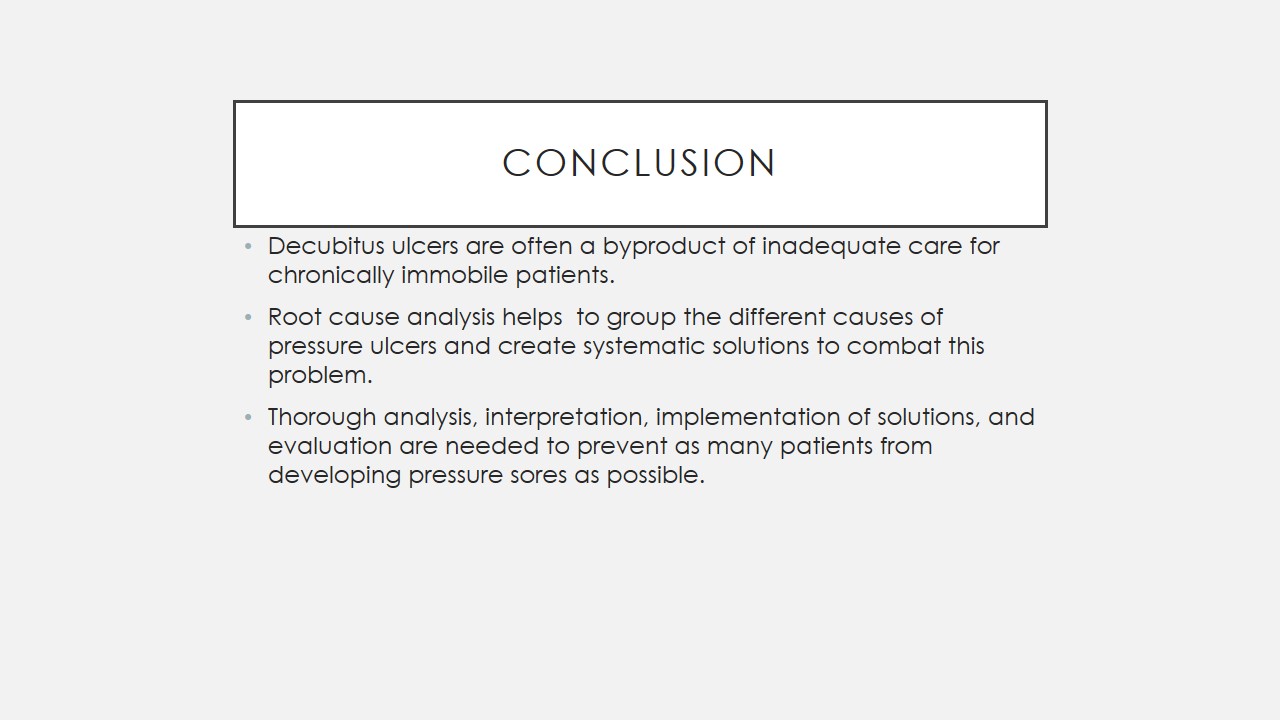
References
Black, J. (2015). Pressure ulcer prevention and management: A dire need for good science. Annals of Internal Medicine, 162(5), 387-388. Web.
Carville, K. (2018). Pressure Injury Prevention and Management in Palliative Care. Textbook of Palliative Care, 1-14. Web.
Elahad, J. A., McCarthy, M. W., Goverman, J., & Kaafarani, H. M. (2018). An Overview of Sacral Decubitus Ulcer. Current Trauma Reports, 4(4), 263-272. Web.
Hommel, A., Gunningberg, L., Idvall, E., & Bååth, C. (2017). Successful factors to prevent pressure ulcers–an interview study. Journal of Clinical Nursing, 26(1- 2), 182-189. Web.
McInnes, E., Jammali‐Blasi, A., Bel l‐Syer, S. E., Dumville, J. C., Middleton, V., & Cullum, N. (2015). Support surfaces for pressure ulcer prevention. Cochrane Database of Systematic Reviews, (9). Web.
Qaseem, A., Mir, T. P., Starkey, M., & Denberg, T. D. (2015). Risk assessment and prevention of pressure ulcers: a clinical practice guideline from the American College of Physicians. Annals of Internal Medicine, 162(5), 359-369. Web.